Resources for the New Beekeeper
By: Richard Wahl
There Are Many Options
It took me some time after my first swarm catch, which was my introduction to beekeeping, to find reliable sources of information for my beekeeping efforts as I had virtually no knowledge of how to manage a box full of potentially stinging insects. I initially started out by purchasing a book or two and watching YouTube videos. In my second year with bees, I became aware of a local beekeeping club. After about ten years’ experience and assisting several other area new beekeepers, I was asked to teach a beginner beekeeping class as part of a local, after school community enrichment program. Only then did I discover larger scale beginner classes offered by the Southeast Michigan Beekeepers Association (SEMBA). This past year I was invited to become a part of that instructor staff and have since assisted in mentoring beginning beekeepers within that organization. This article is devoted to the advantages of taking a class or joining a club that can provide answers for many of the ‘how to” questions of the newer beekeeper. There are also many books available on the subject and I will point out a few of my favorites near the end of this article.
Take a Beekeeping Class
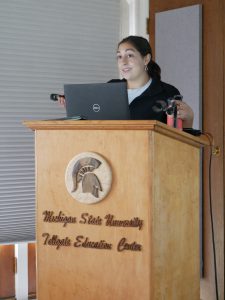
Tollgate guest speaker Ana Heck.
SEMBA instructors have at least four to five years of beekeeping experience with most in the ten years plus range. With the assistance and support of the Michigan State University (MSU) entomology department, which devotes some of its time to honey bee research, these mentors are able to utilize space on two MSU off campus farm research facilities, Tollgate Farm and Bowers Farm, where beginning beekeepers can keep their first hives throughout the late Spring and Summer. Classes meet in person at each facility on Sunday afternoons, starting once a month in January until July and August when meetings occur twice a month and once a month thereafter until twelve sessions have been completed. Unfortunately, the 2020 and 2021 sessions could only meet virtually due to the COVID restrictions. This greatly diminished any “hands-on” experience that students would otherwise receive. But this past Spring and Summer, around fifty students took advantage of the hands-on benefits of the class with instructors and students split between the two locations. After their first few months of class participation, students are encouraged, but not required, to purchase a nucleus (nuc) hive and the necessary bee equipment from a seller of their choice. Most students purchase nucleus hives from the instructors and then set them up at one of the two farm locations. A few students simply take the class without purchasing a hive to learn before jumping in as an active beekeeper and observe others’ hives for their first year, which is also acceptable. A list of the topics covered in each of the two-hour classes this past year can be found on the internet at “2022 SEMBA Beginner Bee School” under class schedule. One of the unique benefits of the class is that class coordinators bring in well-known guest speakers that have done bee research or have written extensively about beekeeping. This past year’s guest speakers have included Dr. Meghan Milbrath, assistant professor in the department of entomology at MSU, Ana Heck, an apiculture extension educator from MSU and Dewey M. Caron, an emeritus professor of entomology and author of the book, Honey Bee Biology and Beekeeping. This book was used as the core class text for outside reading and was included as part the class tuition fee.
Additionally, many of Dr. Meghan Milbrath’s published articles were used as valuable resource information. Both Meghan (at Bowers) and Ana (at Tollgate) gave some hands-on assistance to students during their guest speaker visits at either location. Since the classes at both locations occur at the same time, a Zoom connection allowed the other half to watch their presentations during subsequent class sessions. An interesting aside is that at Meghan’s visit to the Bower site, while she assisted a student with their first hive inspection, they found evidence of European Foulbrood in the hive. This served as an excellent hands-on learning opportunity for all of the Bowers students to actually see and discuss how to handle this disease in real time. The hive was removed shortly thereafter and quarantined with appropriate treatment actions and a replacement provided to the student beekeeper.
The Adventures in Beekeeping
To provide a basis for this article, I interviewed nearly all of the staff of the 2022 SEMBA beginner beekeeping schools. In each interview I asked each staff member three simple questions (or so I thought):
1. What is the most unusual, unique, challenging or exciting thing that has happened to you as a beekeeper?
2. What do you see as the greatest benefit of joining a club or taking a class?
3. What one, most valuable, piece of advice would you give any beekeeper, new or experienced?
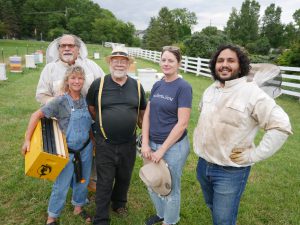
The Tollgate Instructors in the beeyard (from left to right): John Dechart, Cecilia Infante, Rich Wieske, Michelle Kinney and Mohammed Cherri
The response to question number two in my interviews was the most consistent and near unanimous. Most instructors cited the vast exchange of ideas, resources, expertise and information that is available in a class setting. Michelle Kinney, who handles all the administrative duties for the SEMBA bee school’s staff stated that, “Networking with others and learning all the different choices and options that are available to make beekeeping work for your own particular situation and environment is crucial to being successful.” She quoted the age-old axiom among beekeepers that, “If you ask ten different beekeepers a question you will get ten different responses or solutions as an answer.” Having a variety of choices is not necessarily a bad thing as each beekeeper will have different environmental constraints and desired outcomes and therefore must choose what works best for them. There are hive style and equipment choices along with many mite treatment options as well as the ability to recognize a myriad of different activities that go on in the hive. Becoming aware of the large number of options and differences will only aid in the new beekeepers’ potential for success. Rich Wieske, president of MBA and the SEMBA bee school director, with twenty-four years of beekeeping experience, went on to say that, “Having the support of other beekeepers as well as being able to ask questions and get relevant answers from those with prior experience is a needed asset in order to be successful.” Mohammed Cherri, a Tollgate instructor, stated that, “Beekeeping seems like an individual endeavor, but it takes a community of knowledge to learn needed skills and to be able to recognize the pitfalls.”
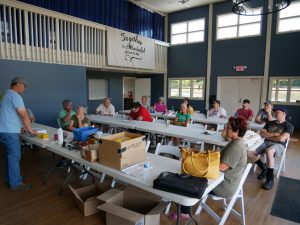
Instructor Preston Zale explaining mite treatments to the Bowers class. Mark Spencer is seated to the farthest right.
While the response to my second question was quite consistent and similar across the entire staff, the responses to my first question had a much greater variety as would be expected. Two of the instructors stated that their first harvest of honey was the most exciting event of their beekeeping careers to date. John Dechart, with a mere five years beekeeping experience among the Tollgate instructors stated such, after jokingly revealing “I have never made any mistakes, haha”. Mark Spencer, a Bowers instructor with eleven beekeeping years, stated his first honey harvest was a big event with about twenty family and friends present to sample his bees’ honey in the very first year of his beekeeping efforts. Lisa Stinson, also with the Bowers instructor staff, stated that her most unique aspect, “Is that I am amazed that I even am a beekeeper,” and that she really appreciated being able to spend time in her hives during the COVID shut-downs when nearly all other activities were curtailed. Preston Zale, the Bowers school coordinator and lead instructor with about ten years’ experience, told about the time he purchased some queens from a dealer in another state. The draw to go out of state was that they came with a thirty day warranty. Going out of state to pick them up involved a day trip and back. He soon learned in his early beekeeping venture that thirty days is not enough to determine any long-term outcome. The hives in which he placed those queens became quite aggressive and none of them made it through the following Winter, even though he took no honey from them, by which time the warranty had long expired. Meanwhile the Tollgate lead instructor, Cecilia Infante, stated that her biggest surprise was that after being stung a few times in her first efforts, her arthritis problems went away for nearly a year. I can also attest to that and although I prefer not to get stung, my own arthritis issues seem to go away for a period of time after receiving a sting.
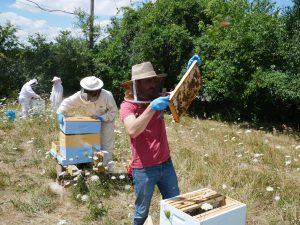
Bowers students inspecting their hives, some a bit braver than others.
It seems the more one delves into the art of beekeeping, the greater number of medical benefits that can be found with use of hive by-products, as well as the honey. Rich Wieske said his most memorable experience was the first time he pulled a frame from a hive; he thought it was capped honey where it turned out to be capped brood and he hastily returned it to the hive. He also stated that when recently setting up a hive while getting a nuc ready to be moved in, watching bee foragers from another hive checking it out was quite interesting. Another interesting observation occurred while he watched a swarm move into a hive. I also once watched in amazement as a massive bee swarm army that dropped outside the hive, marched across the grass to go into the new hive. I can also say that watching a swarm exit a hive, circle in a thirty-to-fifty-foot area outside the hive, and after only ten to fifteen minutes coagulate into about a five foot diameter circle and fly off causes a flush of conflicting emotions. It was exhilarating and exciting to witness one of nature’s reproduction phenomena and at the same time, disappointing to realize probably half of that hive of mine just flew away as happened in my apiary several years ago. I have learned it is better to split a populous hive early, which seems to negate most of the swarming tendency. Another interesting response to my first question came from Mohammed Cherri, who explained his most unusual experience with bees as follows: doing a check of a hive, he found the queen with intentions to mark her. However, during handling, the queen appeared to be dead, or so he thought. Setting the dead queen aside he bought a new queen to replace her. But upon going to replace the aforementioned comatose queen, she was alive and well, moving around the hive as normal. The explanation being that for some reason, during handling, the queen had fainted and had since recovered. Although this is not a common occurrence, I have found other instances and referenced sources that discuss the phenomena of fainting queens along the same lines as fainting goats. Although fainting queens was an area I had never heard of before, and proved to be an interesting response to my first question, I think Kerry Wysocki, an experienced Bowers instructor, had the most interesting, if not somewhat amusing tale to tell. Kerry related that she had been asked to assist a fellow beekeeper do some hive inspections. The requesting individual had some recent health issues and was moving about in a wheelchair with his dedication to beekeeping unwavering. During a running commentary about the frames in the hives they were inspecting, they realized they had pulled a frame with an emerging queen. They had previously spotted another queen in the hive and knew one or the other would most likely get killed if they were both left in the hive together. Not being totally prepared to find a second emerging queen they had to quickly find a container in which to catch this second queen. A quick search occurred and all they could find was a zip-lock baggie. The second queen was placed in the zip-lock inflated bag to take home to be inserted in a nuc. So while Kerry drove them to the location with the nuc, her friend would open the bag every so often to let in a bit of cooler fresh air from the car’s air conditioning vent with the concern to not overheat or asphyxiate the new queen. Arriving at the home of her friend, a nuc with brood frames was quickly assembled, while she and the wheelchair bound beekeeper listened to his wife berate them on the hazards of becoming overly stressed while working the bees and possibly exacerbating his health condition. All ended well however, with brood and a new queen in a nuc which was then successfully overwintered. I can only imagine what type of explanation would have been given if they had been pulled over by a cop.
These memories and conversations are but a few of the socially driven lessons and experiences I have been witness to with others in a classroom/teaching type setting. They may seem a bit off the target of what the class offers, but more specifics can be learned about our particular school by going to “2022 SEMBA, Beginning Bee School” on an internet website search engine. With the recent uptick interest in beekeeping, there are many agencies available that offer classes in beekeeping.
Join a Club
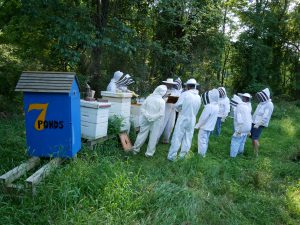
Club president, Preston Zale, explaining hive elements to Seven Ponds Bee Club members out in the bee club demonstration yard.
According to the Michigan Beekeepers Association (MBA) there are about thirty-two bee clubs in the state of Michigan. I suspect there are like numbers in many of the more bee colony populated states and other countries. Club membership is the first organization where I began to learn much more in-depth knowledge about beekeeping. The cost of becoming a bee club or association member is in most cases a minimal amount per year and well worth the money spent. The MBA, SEMBA or any area club can provide an opportunity to exchange information with other beekeepers with various degrees of experience and knowledge and many organizations have websites that can be found by typing the name or acronym into a search engine. As Kerry Wysocki, current president of the Oakland Beekeepers club states, “It is a great way to exchange ideas and share experiences while learning about beekeeping.” And Seven Ponds board member at large, Lisa Stinson, states “When I got involved with the club my bees started surviving.” I am sure that my own joining of the local Seven Ponds Bee Club had a lot to do with my continuation in beekeeping. In the case of the Seven Ponds Bee Club, meetings are held once a month at a rural county nature center where three to four bee hives are maintained on site for teaching purposes.
When weather permits, club members can arrive early on meeting nights to go through hive inspections with the club hive maintainers, in our case club president, Preston Zale, or club vice president, Mark Spencer. Yearly membership dues are kept at a nominal $10.00 per year by way of holding a quick raffle prior to each meeting. Members donate bee related items, tickets are purchased and just before the meeting starts, a drawing is held to choose winners. The first drawn winning ticket gets to choose any of the evening’s donated items on the table with each subsequent drawn ticket winner choosing from what remains until all items are removed. Enough funding is attained through the raffles such that facility use costs are covered, the club can bring in guest speakers such as those mentioned above for the Tollgate and Bowers classes and the raffles or Summer picnic smoker challenge contest can field prizes as big as nuc hives, queen bees or hive tools such as refractometers or hot knives.
But best of all as Mohammed Cherri states, “Join a club or take a course, nothing beats local knowledge.” I believe that Dawn Gialanella, a SEMBA bee school student and at large board member of the Seven Ponds Bee Club summed it up the best when she stated that, “Bee clubs help you keep bees while bee schools teach you how to keep bees.”
Sage Advice from Experience
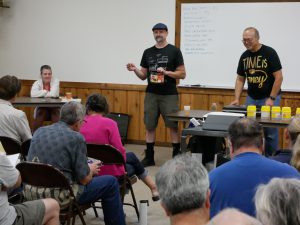
At a Sevens Ponds club meeting; board member at large, Dawn Gialanella sits at the raffle table as vice president Mark Spencer pulls the next ticket and president Preston Zale, looks on.
The interviewees had a variety of answers for my third question about providing advice. Several noted the need to stay ahead of varroa mite loads with John Dechart stating, “What you don’t spend in varroa treatment you’ll be spending in replacing your hives.” While Kerry Wysocki put it more bluntly stating, “Have a plan for varroa mites and execute that plan or your bees will die.” Michelle Kinney feels, “It is important to stay on top of bee news and the latest treatment options as the environment of beekeeping is continually changing.” Preston Zale suggests, “Always light your smoker and have it at the ready. When something needs to be done, do it regardless of the weather.” Along those same lines Lisa Stinson stated, “Go with your gut intuition when making decisions on what to do since waiting may only expand the problem.” Rich Wieske however lends a degree of caution saying, “When you get a new idea, try it on only one hive first; and get comfortable opening your hives for checks on a regular basis.” I feel Mark Spencer summed it up by saying, “Enjoy the experience, listen to your bees, it’s a lot of work, but remember why you did it.”
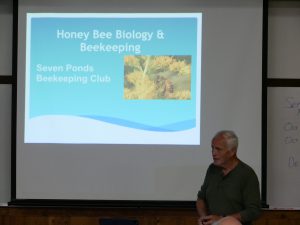
Gordon Wardell, who holds a PhD in entomology from MSU, and a founder of the MegaBee pollen supplement company gives a presentation to the Seven Ponds Bee Club.
Read Some Books, Subscribe to a Magazine (like Bee Culture!)
Lastly, I said I would say a few things about books. I would have to say my favorite book so far is the ABC and XYZ of Bee Culture by A. I. Root because of a bit of nostalgia. The 1929, third edition of this 800-page, hard cover book was owned by my grandfather who for a time kept bees on the family farm. Upon the passing several years ago of a 95-year-old aunt of mine, this book that I never even knew my grandfather had, was inherited by me as the only family member currently interested in beekeeping. I have read this book several times and it surprises me how much nearly one hundred-year-old techniques are still used today while the current edition (the 42nd edition) incorporates many recent changes to the management of bees. (Get it here: https://store.beeculture.com/42nd-edition-of-abc-xyz/)
Another book that has proved most useful and as mentioned before as being used as our class text, is Honey Bee Biology and Beekeeping by Dewey M. Caron. This book not only covers many aspects of how to be a successful beekeeper but gets into much of the underlying bee anatomy and why bees are as successful as they are in what they do. Both of the current editions of these books run in the $75.00 price range. If looking for something less expensive that still covers the basics quite well, I would suggest the paperback The New Starting Right with Bees by Kim Flottum and Kathy Summers (Get it here: https://store.beeculture.com/the-new-starting-right-with-bees/)or The Backyard Beekeeper by Kim Flottum (Get it here: https://store.beeculture.com/the-backyard-beekeeper-4th-edition/). Both can be found as used copies for as little as $5.00. To get off on the right foot in beekeeping Cecilia Infante recommends, “Spend your first year learning and reading from everyone before buying bees or any one item of beekeeping gear.” These books and many others would be a good place to start. Naturally there are also monthly beekeeping magazines to which one can subscribe. Of course, I am biased toward “Bee Culture The Magazine of American Beekeeping” which has been publishing my articles this past year. Whichever direction you choose to take with your beekeeping education, there are seemingly unlimited resources available. Choose learning as a partner condition with your beekeeping and I do not think you will be disappointed with the potential rewards of working with this fascinating insect.








